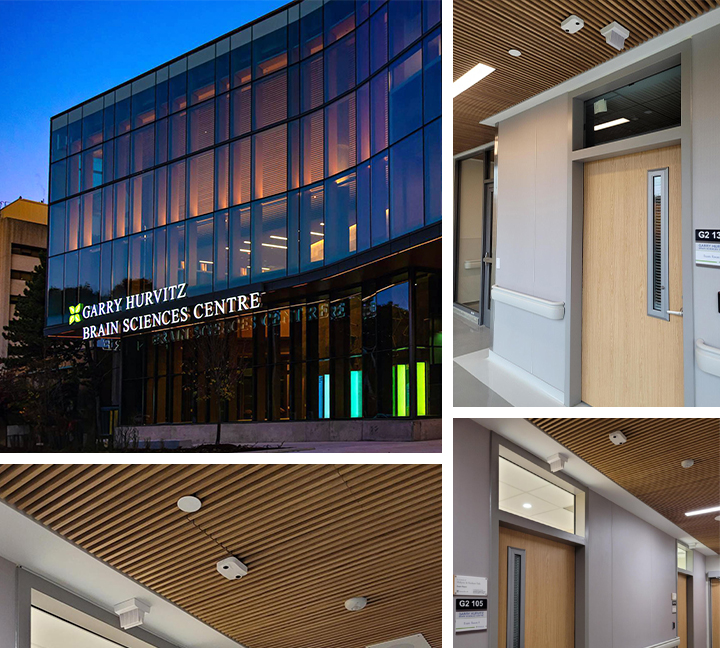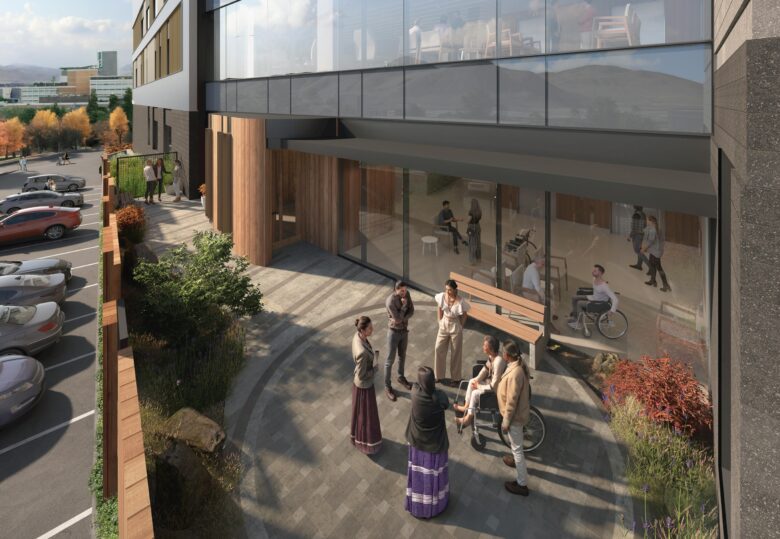Sector: Healthcare
Northern Health Authority
Dawson Creek & District Hospital Replacement Project Operational Readiness
BC's Northern Health Authority is building a state-of-the-art hospital as a model of excellence in healthcare. The new Dawson Creek & District Hospital is being built in Treaty 8 territory, the ancestral home of the Beaver, Cree, Saulteau, Sicannie (Sikanni), and Slavey, and will serve numerous diverse communities.
The Dawson Creek and District Hospital (DCDH) is a 263,000 ft2 facility on a greenfield site, replacing the existing hospital. This three-story hospital will house an emergency department with 15 treatment spaces and 70 inpatient beds offering medical, surgical, maternity, high acuity, and mental health services. Additionally, it will feature 2 operating rooms, a procedure room, diagnostic imaging, a chemotherapy area, a perinatal unit comprising labor, delivery, recovery, and postpartum rooms, a nursery, mental health department, academic and teaching space, along with pharmacy services. The facility is being designed to meet LEED Gold certification standards.
As part of a comprehensive operational readiness engagement, Angus Connect is supporting DCDH through a structured, multi-phase approach to ensure a smooth transition to operational status. Our scope of work was divided into three main phases:
- Phase 1: Project initiation and assessment
- Phase 2: Development and implementation
- Phase 3: Transition plan, move, and learn (targeted: Summer 2026 – Summer 2027)
Each phase addresses specific readiness needs, while ensuring continuous alignment with the hospital’s operational and clinical objectives. In the first phase, Angus Connect worked closely with DCDH leadership and operational teams to establish a solid foundation for the hospital’s operational readiness. This involved educating key stakeholders about the process and their roles, facilitating workshops to develop a master schedule that aligned project milestones with hospital priorities, and assessing the organization’s preparedness for operational readiness planning. A comprehensive Operational Readiness Project Charter was created, outlining governance structures, planning assumptions, risk management strategies, and stakeholder engagement approaches.
The tailored operational readiness framework was a core deliverable, providing DCDH with tools, templates, and checklists to guide clinical and non-clinical program readiness. This framework addressed key elements such as change management, workflow redesign, human resource planning, equipment strategies, and emergency measures planning. A Gap Analysis was conducted to assess current clinical offerings and identify areas that required specialized resourcing for the transition. The findings were used to develop Change Maps that identified areas where large changes were going to take place. Examples of these are technology and equipment changes that could transition a hospital from manual paper-based workflows to integrated digital systems.
Our team conducted patient journey mapping for clinical departments and materials mapping for non-clinical operations for a clear understanding of new logistics and process flows. Training requirements identified fed into the development of the Orientation, Training, and Education Tracker, a tool designed to identify all mandatory training and orientations for the hospital.
To align each department’s readiness with the broader operational goals, we facilitated a corporate opening day view session with program leaders to define future-state requirements, develop and confirm service delivery models, and identify inter-departmental dependencies. The outcomes provided a foundational understanding for all clinical and non-clinical departments on what First Patient Day would look like.
Phase 2 focuses on the development and implementation of detailed operational readiness work plans for all programs, services, and subcomponents. These plans address the gaps between the current and future operational states, breaking down desired plans into necessary tasks. The phase involves workflow and process redesign, clinical model of care planning, equipment planning, risk management, emergency measures, and internal and external communication strategies.
Angus Connect also provides strategic guidance on ICAT and equipment planning, supports early visioning for Departmental Opening Day Views, and facilitates a risk workshop to identify challenges and mitigation strategies. Phase 3 will include the development of Transition Plans for activities leading up to Opening Day, ensuring the hospital is fully operational and supported until after three months post-occupancy.
Our team’s operational readiness support sets the stage for successful implementation of all phases of the project, providing DCDH with a clear, structured path to achieving full operational capacity in the new hospital.
SERVICES
Operational Readiness Consultant
PROJECT FEATURES
263,000 ft2 three-story facility | Serving Treaty 8 First Nations, Métis, and Peace Region communities | Targeting LEED Gold certification | Completion 2027
LOCATION
Dawson Creek, Alberta
KEY SCOPE ELEMENTS
Comprehensive Operational Readiness framework | Gap analysis | Change maps | Patient journey mapping | Opening Day view session | Development and implementation of operational readiness work plans | ICAT consulting | Transition plans



Images Courtesy of Graham and Northern Health.
Infrastructure Ontario
MECP-MLITSD Science Facility Complex
The new complex will bring together existing operations into a single, modern, science and laboratory facility that will strengthen capacity to deliver on critical mandates of protecting the environment, public health, and safety.
The new Science Facility Complex will permanently replace Ontario's Ministry of the Environment, Conservation and Parks’ (MECP) facility at 125 Resources Road and Ministry of Labour, Immigration, Training and Skills Development’s (MLITSD) temporary facility at 6295 Northam Drive (formerly at 81A Resources Road).
HH Angus’ Science and Technology team is providing compliance (PDC) engineering services for this Design-Build-Finance-Maintain (DBFM) infrastructure project that will protect public health and the environment through advanced monitoring of radiological materials, environmental contaminants, and live viruses. The new facility will have purpose-built, flexible design to allow for adaptable laboratories, science workshop spaces, and offices to support both current operations and future growth.
SERVICES
Mechanical Compliance Engineering | Electrical Compliance Engineering | ICAT Compliance Engineering
PROJECT FEATURES
P3-DBFM | Targeting LEED Silver certification | Flexible and adaptable laboratory and office spaces | Status: Ongoing
LOCATION
Oakville, Ontario
Michael Garron Hospital
Patient Care Centre ICAT Strategy
HH Angus was engaged as part of the Compliance team for the new eight-storey Patient Care Centre at Michael Garron Hospital (MGH), formerly Toronto East General.
The project also included a three-storey connection, as well as demolition and renovations to the existing hospital. MGH is a large community hospital serving the diverse Toronto community of East York. Many of the buildings are old, some dating from 1927.
Angus Connect assisted in developing a long term IT strategic vision for the Hospital, including directions, gap analysis, strategic recommendations and Information Technology (IT) solution options for IT to support the hospital moving forward. The Hospital aimed to achieve EMRAM level 7, the highest level in becoming a paperless and digital facility. It also looked to identify automation opportunities to become a smarter hospital. Angus Connect fulfilled the Compliance role for the Hospital, preparing the PSOS for ICAT systems and integration requirements in integration matrix and interoperability use case definition.
The new Patient Care Centre redevelopment was the first phase in the master plan for the site, addressing the highest priorities – namely, consolidated facilities for outpatient services, replacement of inpatient beds in older wings, and several related non-clinical areas. The Redevelopment adds approximately 550,000 ft2, including a new tower to house inpatient and mental health beds, ambulatory clinics and a new underground parkade. It also included approximately 100,000 ft2 of renovation within the existing facility, including a Cardiac Catheterization Suite and administrative areas. The project has been certified LEED v4 BD+C Silver.
As the Angus Connect team developed the technical output specifications, they reviewed options for phasing and system integration. Design standards and technical guidelines, incorporation of operations, life cycle and maintainability requirements are of the utmost importance for this project, as the facilities’ operation and maintenance became the responsibility of the Hospital upon completion of construction.
SERVICES
Compliance Engineer for ICAT Design
PROJECT FEATURES
8-storey patient care centre | 3-storey connection to existing hospital | Completion 2023
LOCATION
Toronto, Ontario
KEY SCOPE ELEMENTS
ICAT compliance | 550,000 ft2 added space | 100,000 ft2 of renovations to existing hospital | Long-term IT strategic vision | PSOS for ICAT systems | Targeting LEED Silver
Image Courtesy of Michael Garron Hospital
Interior Health
BC Cancer Centre
The new BC Cancer Centre is described as the single largest capital investment into the expansion of cancer care in the Kamloops region.
Interior Health, in partnership with BC Cancer, is building a new cancer centre at the Westlands site of the Royal Inland Hospital in Kamloops, BC. The new facility includes design and construction of a 5-storey outpatient radiation oncology clinic. Featuring three linear accelerators for radiation therapy, a CT simulator, a diagnostic MRI, ambulatory care space, a 470-stall parkade and an interfaith sacred space for patients and families, the new Cancer Centre will respond to increased demand for cancer services on the main campus, and facilitate 16,500 treatments annually while significantly reducing long-distance travel for many patients.
HH Angus is providing mechanical and electrical engineering, ICAT design and vertical transportation consulting services for this project which is led by EllisDon Corporation.
The Kamloops Cancer Centre is scheduled for completion in 2028.
Image Credit - Interior Health
SERVICES
Mechanical Engineering | Electrical Engineering | ICAT/IMIT Design | Vertical Transportation Consulting
PROJECT FEATURES
5-storey outpatient radiation oncology clinic | Design-Build delivery model | 470-stall parkade | Interfaith sacred space | Completion 2028
LOCATION
Kamloops, British Columbia
Sunnybrook Health Sciences Centre
Space Optimization Study Using AWS QuickSight
Sunnybrook Health Sciences Centre, a leading healthcare provider in Toronto, was seeking to address challenges in medical space utilization. With a diverse array of clinical services and bookable exam rooms, Sunnybrook faced challenges understanding a perceived shortage of space. Yet, intermittent observations suggested that many exam rooms were frequently empty.
M6 – Multipurpose Clinical Space | Yuval & Lori Barzakay Brain Health Clinic Study
To gain a clearer understanding of space utilization and identify potential inefficiencies, Sunnybrook partnered with HH Angus, leveraging our expertise in digital solutions and innovative engineering. The goal was to implement a robust monitoring system to capture accurate data on room usage, enabling informed decisions on resource allocation.
This project reflects Sunnybrook’s commitment to operational efficiency, ensuring that resources are optimally allocated to improve patient care and support staff needs.
SERVICES
Prime Consultant
PROJECT FEATURES
Digital monitoring system to inform clinical resource allocation | Enhanced operational efficiency | Patient privacy | Scalable design | Predictive analytics
LOCATION
Toronto, Ontario
KEY SCOPE ELEMENTS
Space utilization measurement and analysis | Data acquisition through sensor deployment | Security and connectivity | Data aggregation and storage | Visualization and insights
Solving Space Utilization Challenges
Sunnybrook’s medical staff expressed concerns about limited space availability, particularly for bookable exam rooms. However, casual observations indicated that some rooms appeared to remain empty. Sunnybrook needed a reliable solution to measure actual room usage accurately while addressing two significant concerns:
Privacy: Ensuring patient privacy was paramount, particularly in sensitive clinical settings.
Accurate Detection: Existing solutions struggled to detect minimal motion, such as during procedures like blood transfusions, where patients may remain largely still.
HH Angus was engaged to design and implement a solution capable of addressing these challenges while delivering actionable insights.
Solution | Smart Sensors and AWS Integration
Our Digital Services team developed an innovative solution leveraging cutting-edge sensors and AWS services:
Sensor Deployment:
-
- mmWave Sensors: Initial deployment involved mmWave sensors capable of detecting micro-motions, such as breathing, to confirm room occupancy. These sensors were equipped with cellular SIM cards to operate independently of Sunnybrook’s network.
- 3D Stereoptic Sensors: To further expand the data gathered from the various clinics, the move to 3D-stereoptic sensors was used to provide not just occupancy status of exam rooms, but also the near real-time occupancy count data. Enhancing scalability, these sensors could monitor multiple rooms simultaneously, offering greater hardware efficiency.
Security and Connectivity:
-
- mmWave sensors utilized mTLS (mutual Transport Layer Security) for secure data transmission.
- Custom authorization for 3D-stereoptic sensors was implemented using AWS Lambda.
Data Aggregation and Storage:
-
- Data was streamed via Amazon Data Firehose and AWS IoT Core, stored in AWS S3, and processed through AWS Lambda.
- A centralized S3 data lake provided a secure, scalable repository for all processed data.
Visualization and Insights:
-
- Data queries were conducted using AWS Athena, while AWS QuickSight offered intuitive 2D dashboards for near-real-time analysis with minimal latency.
This comprehensive approach ensured seamless integration, robust data security, and actionable insights for Sunnybrook.
Outcome | Actionable Insights and Future Expansion
The solution provided Sunnybrook with detailed, data-driven insights into space utilization:
Initial Findings: The installation was completed in December 2024, and data collection began in January 2025. Analysis of the 11 monitored exam rooms in Sunnybrook’s M-Wing, conducted from January to March 2025, revealed a surprising utilization rate of only 33%. This insight challenged initial staff assumptions and highlighted opportunities for more efficient space planning.
Future Outlook: New medical clinics, which opened in January 2025, will contribute additional data to further refine Sunnybrook’s understanding of space usage and inform future expansion strategies.
Through this project, Sunnybrook is well-positioned to optimize its clinical spaces, ensuring that resources are allocated effectively to enhance both staff workflows and patient care delivery.
Key Outcomes Summary
Accurate Space Utilization Data: Revealed underutilization of monitored exam rooms, providing actionable insights.
Efficient Resource Allocation: Enabled informed decisions about space planning and allocation.
Scalability: Designed for expansion, with sensors deployed to additional clinics.
Improved Patient Care: Enhanced operational efficiency supports better patient care delivery.
Predictive Analytics: Tool for staff to forecast resourcing needs based on the day of the week using historical trends
Privacy Assurance: Leveraged secure sensor technologies to maintain patient confidentiality.
AWS Services Used
AWS S3 (Simple Storage Service): Acted as the central repository for storing and
retrieving large datasets, facilitating data analysis and accessibility.
AWS IoT Core: Enabled secure, scalable connectivity for IoT devices, allowing for efficient data collection and integration into the cloud.
AWS Athena: Offered an interactive query service to analyze data in Amazon S3 using SQL, simplifying the extraction of actionable insights from complex datasets.
AWS QuickSight: Provided visualization tools and dashboards for business intelligence, enabling Manulife to derive and act upon insights from their data effectively.AWS Lambda: Supported serverless computing, automating data processing and transformation tasks without the need for server management.
Amazon Data Firehose: Streamlined the capture, transformation, and loading of streaming data, ensuring efficient data flow from IoT devices to storage and analysis tools.
AWS IoT Events: Monitored sensor data for specific conditions, facilitating real-time alerting and response mechanisms to optimize building operations.
AWS Step Functions: Orchestrated complex data processing workflows, coordinating the various components of the ETL pipeline for streamlined operation and maintenance.





